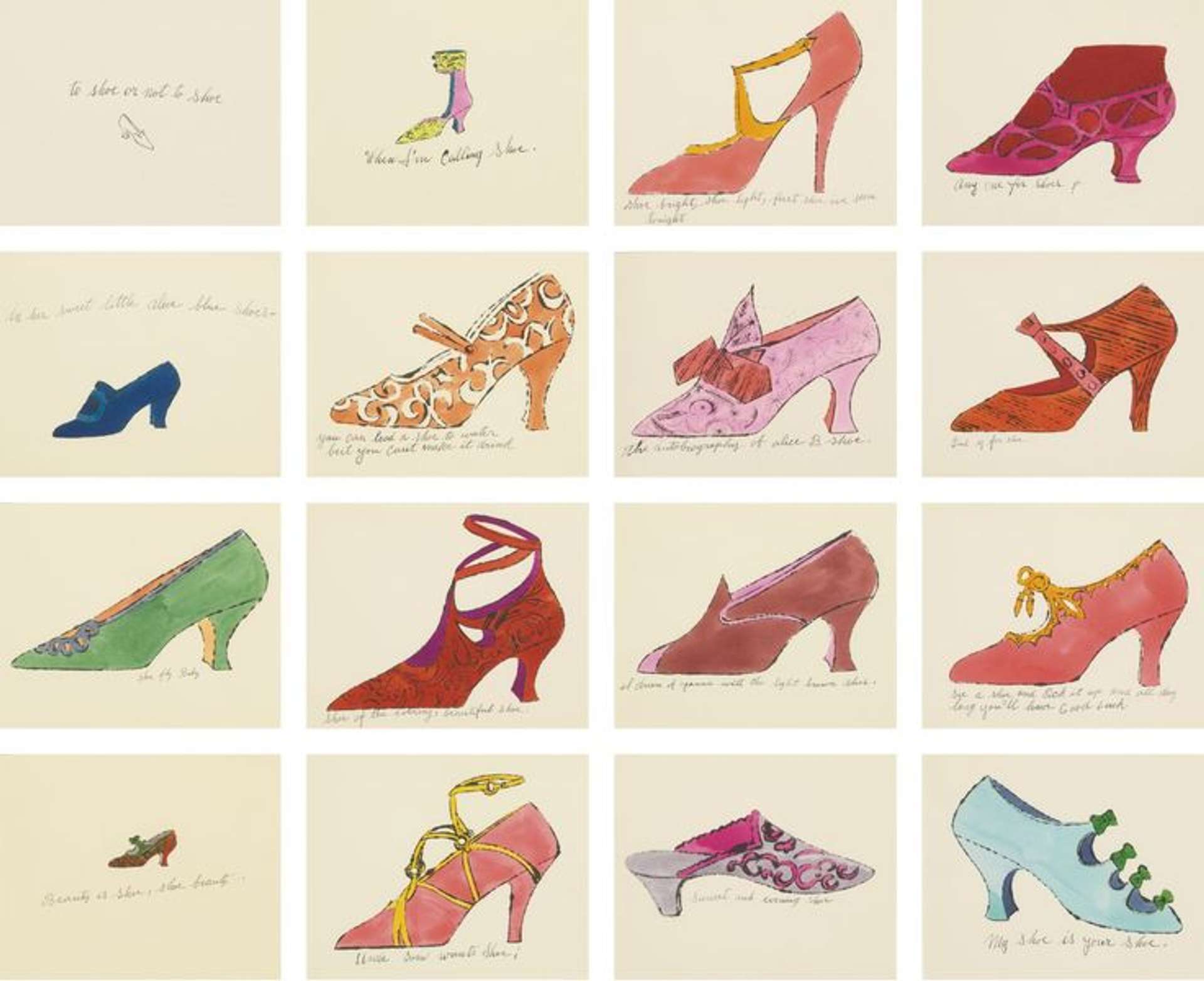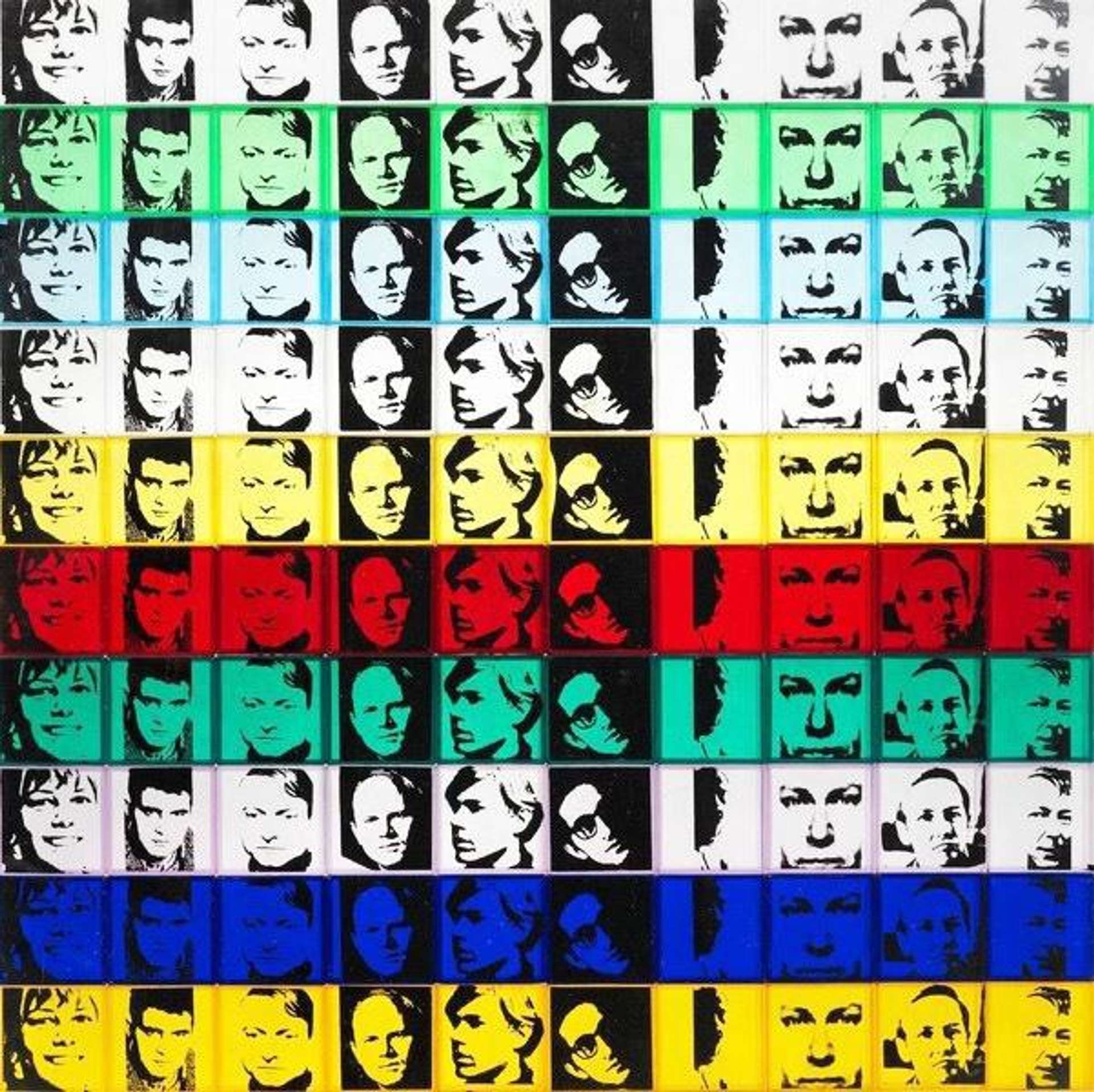 You Can Lead A Shoe To Water But You Can’t Make It Drink © Andy Warhol 1955
You Can Lead A Shoe To Water But You Can’t Make It Drink © Andy Warhol 1955
Interested in buying or selling
Andy Warhol?

Andy Warhol
487 works
Andy Warhol, an emblem of the Pop Art movement, explored the delicate interplay between celebrity, fashion, everyday objects and art. Among the most captivating of these is his shoe series – two collections, at distinct points of his career, that melds whimsy with depth and humour. From his early beginnings as an illustrator, when he was called "the Leonardo da Vinci of the shoe trade" to his pinnacle in the 1980s, the motif is present in his work. The artistic merit of Warhol's shoe series lies not just in its representation of the object, but in its manifestation of a culture.
Shoes as A Motif Throughout The History of Art
Shoes have long held symbolic significance in art, mirroring societal values, cultural shifts, and personal narratives across time. Their representation can provide insights into various aspects of life, from socio-economic status to personal identity and expression.
In medieval art, shoes like poulaines feature heavily in the artwork, and were associated with wealth and luxury, as their impracticality would prevent the wearer from carrying out any type of manual labour. Often, they were subjected to sumptuary laws, with wearers taxed for the privileged of wearing them or altogether forbidden from doing so. During the Renaissance, as the artistic focus shifted more towards everyday life, different varieties of shoes appear in art, although not usually as the sole subject of the artwork. In Jan van Eyck's Arnolfini Portrait, for example, a pair of wooden slippers features prominently in the bottom left corner.
As art moved towards Realism and Impressionism, shoes began to tell more personal stories. Vincent van Gogh painted many still lives of shoes, of which A Pair of Shoes is a poignant example. This seemingly straightforward depiction of worn-out boots becomes a reflection on the labour and the hardships of peasant life in the 19th century. In the early 20th century, Salvador Dalí chose a women's shoe as the subject for his work Surrealist Object Functioning Symbolically. Throughout the 1930s, shoes often appeared in Dalí work, conjuring Freud's fetishism theory and serving as stand-ins for Gala, his wife and muse.
Warhol was building on these traditions and on his own background as an illustrator when he decided to incorporate the shoe motif into his art.
Warhol's Beginnings as a Fashion Illustrator
Before Warhol became a global icon, he began his career in New York City as a commercial artist and illustrator, with a special focus on the fashion industry. This was his first job after graduating with a degree in Pictorial Design from Carnegie Institute of Technology (now Carnegie Mellon University) in 1949. He soon found work as a freelance illustrator for several magazines, including Glamour, Vogue and Harper's Bazaar.
Warhol's unique and whimsical style, which often employed a blotted line technique, set him apart. The blotted line technique involved tracing over an original drawing with ink, then blotting it while still wet onto another piece of paper. This method gave his illustrations an almost unfinished look that became quite sought after.
Youtube © The Andy Warhol Museum / Andy Warhol's Blotted Line TechniqueOne of Warhol's first commercial successes in the fashion illustration world was his work for I. Miller, a shoe company. His advertisements, featuring intricately drawn shoes accompanied by playful, hand-lettered captions, became a regular feature in the New York Times. These early shoe illustrations cemented Warhol's reputation in the fashion industry and also hinted at his future obsession with everyday objects and their potential elevation into art.
While Warhol enjoyed a successful career as a commercial artist throughout the 1950s, by the end of the decade, he began to transition towards fine art. His background in fashion illustration and commercial art deeply influenced his later works: the principles of mass production and repetition he employed in commercial art became foundational to his approach in Pop Art, as seen in his famous works like the Marilyn series and Campbell's Soup Cans.
Warhol's beginnings as a fashion illustrator provided him with the skills, perspective and insights that would later feed into his evolution as one of the 20th century's most influential artists. His ability to see beauty and art in the commercial and everyday set the stage for a career that would challenge and redefine the boundaries of "high" and "low" art.
À La Recherche Du Shoe Perdu
À La Recherche Du Shoe Perdu (which translates to "In Search of the Lost Shoe") is a whimsical and illustrative project by Warhol that perfectly marries his early career in fashion illustration with his innate sense of pop culture artistry. It is a series of 16 hand-coloured lithographs centred on the theme of individual high-heeled shoes, each paired with a quirky and often poetic caption written by Ralph Pomeroy, and with calligraphy from Julia Warhola, the artist's mother.
Its title plays on the Marcel Proust's famous "À la recherche du temps perdu" (In Search of Lost Time or Remembrance of Things Past), a notoriously deep and introspective work. Instead, Warhol's is a light-hearted and playful exploration of shoes as everyday objects, infused with his unique artistic flair.
À La Recherche du Shoe Perdu was one of Warhol's first print series, predating the more famous Pop Art works. For this reason, it can be seen as a bridge between his career as a commercial illustrator and his emergence as a fine artist, reflecting Warhol's continuing fascination with everyday objects and his ability to elevate them into the realm of art. It also stands as a testament to Warhol's enduring love for fashion and his understanding of its importance in popular culture.
À La Recherche du Shoe Perdu captures a unique moment in Warhol's career, providing a visually rich exploration of a theme that would continue to fascinate him throughout his life.
À La Recherche du Shoe Perdu captures a unique moment in Warhol's career, providing a visually rich exploration of a theme that would continue to fascinate him throughout his life.
Diamond Dust Shoes
Warhol revisited the shoe theme decades later, when in 1980 he created the Diamond Dust Shoes series. It is a blend of his early work with shoe illustrations and his later experimentation with real diamond dust, composed of various screenprints of randomly scattered, high-heeled shoes adorned with the glittering touch.
The series was created as an advertisement for Warhol's friend Roy Halston's fashion line, and the work is reflective of the artist's place at the epicentre of a shimmering social milieu in the late 1970s and early 1980s. Both he and Halston were regulars at iconic establishments such as Studio 54, mingling into the early hours with luminaries like Jerry Hall, Liza Minnelli, and Grace Jones. The shoes depicted in Diamond Dust Shoes evoke the vibrant glow of the club's lights, as if carelessly discarded on the dance floor in a euphoric haze.
The diamond dust used in the printing process adds a layer of luxury and extravagance to the mundane. It elevates the shoes from mere objects of wear to glamorous artefacts worthy of attention, but also adds visual texture to the work. The reflective quality of the diamond dust changes the adds three-dimensionality, altering it based on the viewer's angle and lighting.
The series stands as a testament to Warhol's continual evolution as an artist. While he had always shown an affinity for shoes as subjects and advertising as a medium, this series elevated these to a new level of luxury and cultural commentary.
The Legacy of Warhol's Love Affair With Shoes
Warhol's shoe series stand as a significant testament to his unique ability to elevate everyday objects into art, capturing his transition from a commercial illustrator to a leading figure in the Pop Art movement and showcasing his fascination with themes of glamour and consumer culture.
Warhol's shoes became symbolic, emphasising the transient nature of fashion and the intersection of commerce with art. His dedication to this motif has left a lasting legacy, inspiring subsequent artists to view everyday objects as potent canvases for cultural commentary and artistic exploration. Tracey Emin, for example, revisited the shoe and alluded to La Recherche du Shoes Perdu in her work You Can't Fuck A Shoe. Yayoi Kusama has also worked with the motif in her print collection Shoes.
Warhol's shoes are ultimately a testament to his growth as an artist and consistent impact on generations to come.









